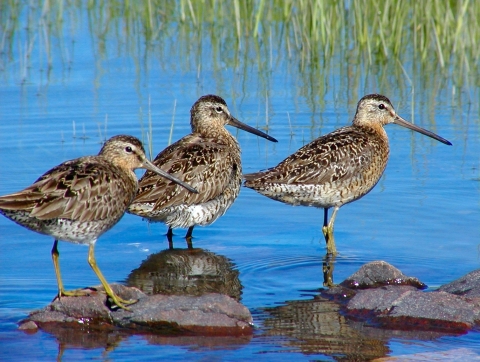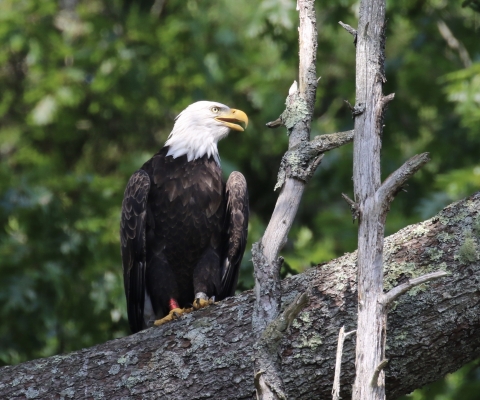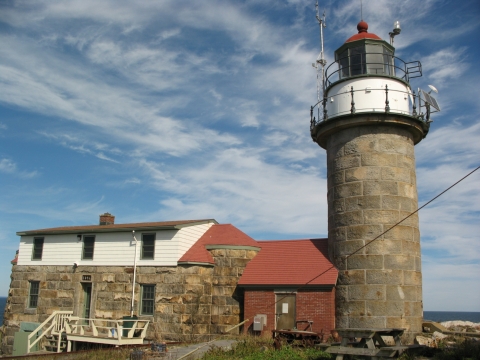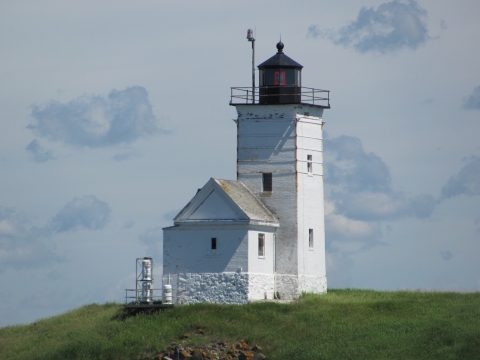About Us
Mainland Divisions
The refuge's four mainland properties are located in Hancock and Washington counties. Upland areas are characterized by spruce-fir forests with some mixed hardwoods. The 2,178-acre Petit Manan Point Division, in Steuben, also includes jack pine stands, coastal raised heath peatlands, blueberry barrens, old hayfields, fresh and saltwater marshes, cedar swamps, granite shores, and cobble beaches. The Gouldsboro Bay Division, in Gouldsboro, protects 635 acres, including mature upland forest and a large tidal saltmarsh and mudflat. The 1,150-acre Sawyer's Marsh Division lies at the head of a broad saltmarsh in Milbridge, just north of Petit Manan Point. The recently acquired 431 acre Corea Heath Division, in Gouldsboro, protects a large, raised, coastal peatland and several populations of rare plants
Neotropical migratory songbirds thrive in the forests of the mainland divisions. These birds breed in North America and winter in the Caribbean, Mexico, and Central and South America. Recently, populations of species such as the American redstart, Swainson's thrush, and song sparrow, have declined due to habitat loss throughout their migratory routes.
The saltmarshes and mudflats of the mainland divisions attract waterfowl, wading birds, and shorebirds.
Black ducks, great blue herons, and American bitterns ply the waters of the saltmarshes. Semipalmated sandpipers, dowitchers, greater and lesser yellowlegs, and dunlins probe the mudflats for invertebrates.
During fall migration, 80-acre Cranberry Flowage on Petit Manan Point is filled with over 4,000 ducks. Black ducks, green-winged teal, and mallards rest and feed on wild rice in preparation for the long flight south. Long-tailed ducks, surf and white-winged scoters, common goldeneyes, and common eiders winter in coastal waters.
The former pastures and blueberry fields on Petit Manan Point provide nesting habitat for grassland birds such as bobolinks and savannah sparrows. In the spring, American woodcock use the clearings for their unique courtship displays. Whimbrels stop off here during their fall migration from the Arctic tundra to the southern United States. The Service maintains open areas through periodic mowing and controlled burning.
Islands
Petit Manan NWR includes 3,180 acres on 67 islands, stretching the entire coastline of Maine. The islands vary in size from 0.5 – 1,312 acres. Eight of the islands are predominantly forested with mature stands of balsam fir and red spruce. Eleven of these islands currently support active bald eagle nests. While the other 56 islands within Petit Manan Refuge may provide some forested habitat, their primary resource value is to the open herbaceous habitat that provides valuable nesting habitat for a variety of seabirds. Refuge staff monitor island resources and conduct biological surveys of the islands’ flora and fauna. Active seabird restoration projects are ongoing on Matinicus Rock, Petit Manan, Metinic and Ship
Seabird nesting islands supporting nesting terns, alcids, Leach’s storm-petrels, or great cormorants are closed to public access during the seabird nesting season: April 1 to August 31. Islands supporting nesting gulls and common eiders are closed to public use from April 1 to July 31. Islands supporting nesting bald eagles are closed to public access from February 15 to August 31.
Other Facilities in this Complex
Lighthouses
Once essential for safe maritime travel, lighthouses now provide sanctuary for nesting seabirds. Five lighthouse islands on the Maine coast have been transferred from the U.S. Coast Guard to Petit Manan Refuge.
Egg Rock Light, Winter Harbor, Maine
- Station Established - 1875
- Present Lighthouse Built - 1875
- Automated - 1976
- Height of Tower - 40 feet
- Height of Focal Plane - 64 feet
- Original Optic / Present Optic - Fifth order Fresnel / 190 mm
- Fog Signal - Two blasts every 30 seconds
- Other Structures Still Standing - 1875 keeper’s house (integral to tower)
Libby Island Light, Machiasport, Maine
- Station Established - 1822
- Present Lighthouse Built - 1824 (?)
- Automated - 1974
- Height of Tower - 42 feet
- Height of Focal Plane - 91 feet
- Original Optic / Present Optic - Fourth order Fresnel / Solar powered modern optic
- Fog Signal - One blast every 15 seconds
- Other Structures Still Standing - 1884 fog signal building
Matinicus Rock Light, Matinicus Isle, Maine
- Station Established - 1827
- Present Lighthouse Built - 1857
- Automated - 1983 (North light discontinued in 1924)
- Height of Tower - 48 feet
- Height of Focal Plane - 90 feet
- Original Optic / Present Optic - Third order Fresnel / DCB -224
- Fog Signal - One blast every 15 seconds
- Other Structures Still Standing - 1864 keeper’s house and 1890 oil house
Petit Manan Light, Steuben, Maine
- Station Established - 1817
- Present Lighthouse Built - 1855
- Automated - 1972
- Height of Tower - 119 feet
- Height of Focal Plane - 123 feet
- Original Optic /Present Optic - Second order Fresnel / DCB -224
- Fog Signal - One blast every 30 seconds
- Other Structures Still Standing - 1875 keeper’s house 1876 engine house, 1887 fog signal building and rain shed
Two Bush Light, Matinicus Isle, Maine
- Station Established - 1897
- Present Lighthouse Built - 1897
- Automated - 1964
- Height of Tower - 42 feet
- Height of Focal Plane - 65 feet
- Original Optic / Present Optic - Fifth order Fresnel / Solar powered modern optic
- Fog Signal - One blast every 15 seconds
- Other Structures Still Standing - None








